 |
 |
Sinai; land of discovery. The route to the Promised Land; where Isis sought Osiris and the Pharaohs found gold. Where Moses witnessed the burning bush and Bedouins camped by Crusader forts. A meeting point for three great religions, at the crossroads of Africa and Asia. After 80,000 years at the heart of history, experience the continuing contrasts. Sinai: where rock meets coral reef and the desert stops at the sea. Where the grandeur of granite meets the golden beaches of the " Red Sea Riviera ". Tropical Fish and rare birds; spectacular sunsets and clear starry nights.Sinai - by its geographical location - is the junction between Asia and Africa. It is shared like an inverted triangle, with the base stretching between Rafah and Port Said, in the north, and the apex, Ras Mohammed, in the south. This prominent and strategic position of the Sinai Peninsula has made it the gateway to Egypt from the east. Sinai’s history goes back to the Pharaohs who explored its land, searching for gold, copper and turquoise. Thus, it came to be known as the Land of Turquoise.
|
Sinai is rich in scenery. To the north, palm-shaded sandy beaches stretch along the Mediterranean shore. Along the Gulfs of Aqaba and Suez, soft golden sands surround bays of clear blue water. There are tourist villages, fishing and snorkeling centers, where the waters are rich with rare marine life and exquisite coral reefs. Sweet water springs are scattered throughout Sinai. In the south, the towering mountains with their beautiful reddish colored rocks are surrounded by huge valleys leading to the Holy Mountain.
Sinai also has various medicinal plants and different kinds of indigenous and migrating birds. |
|
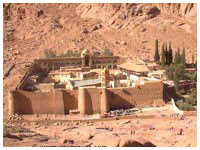 |
 |
Uyun Mussa: |
About 15 km. east of Suez, it is an oasis compromising 12 sweet water springs.
Hammam Fara’un (Pharaoh’s Bath): A group of hot sulfur springs, with at temperature of 72 C at the source. |
| |
Top |
 |
Sourial Mountain:
An object of pilgrimages prior to the advent of religions.
Moses and Sefsafa Mountains: 2 km. long mountain chain, the highest peak of which Moses mountain (Gabal) (Mount Moses): Also known as Mount Sinai, it is said that this is the site where Moses received the Ten Commandments. The climb up the mountain (2,286 meters or 7,498 feet) is an excursion not to be missed.
Monastery of St. Catherine:
This was built in the 6th century and dedicated to the daughter of a ruler of Alexandria, who converted to Christianity and was subjected to great torture. The huge walls of the Monastery surround a number of small churches. On the east wall is an ancient basket and a pulley, which was used instead of opening the door. |
| |
|
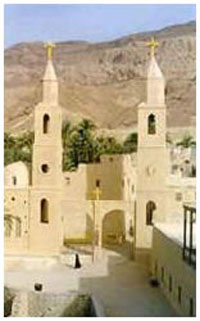 |
Colored Canyon:
So called because the sandstone walls that flank it features remarkable hews and shades of color, ranging from white to yellow and all the shades of red imaginable.
The White Canyon: This natural canyon takes its name from the rainbow hues of the sandstone into which it was carved by water erosion during the Quaternary Period. The walk through the canyon end in the Oasis and palm groves of Ain Khudra.
Ain Khudra: impeded by high mountains , Ain Khudra is distinguished by the great abundance of water and palm trees.
Oasis of Ain Umm Ahmed:
Is one of the least visited, most beautiful in the Sinai. This is a huge palm grove broken by small gardens and orchards.
|
| |
|
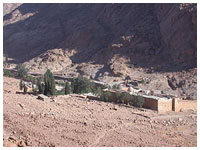 |
Oasis of the Mangroves:
The Mangrove Forest, located in the protected area of Nabq, is the largest and most important in Sinai.
The Temple of Sarabit al-Khadim: Lies on a small hill top north of Al-Tor. It consists of several caves, most important of which are: Cave of the Goddess, Hathor, built during the reign of King Snefru, and the cave of Souidu, the God of War.
National Park of Abou Galloum:
Is among the most picturesque protectorates in the country, with its high mountains, narrow sinuous valleys, freshwater springs, and coastal sand dunes. The turquoise waters are among the best features of the area. |
 |
|
 |
|
Main Visits: |
| Sharm Al-Shiekh: |
| Overlooks the Gulf of Aqaba, and is about 53 km. from Ras Mohammed and 336 km. from Suez. It is both a summer and winter resort due to its moderate climate all year round and depends on fishing and tourism. It is the Mecca of all those who seek tranquility and love the sun. There are several well-equipped diving centers. |
| |
|
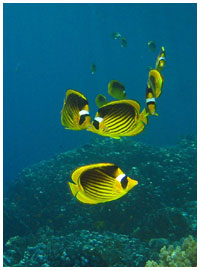 |
Dahab:
About 81 km. north of Sharm Al-Shiekh, it is one of the most beautiful beaches in South Sinai because of its gleaming sand, clear waters and colorful marine life. It has a tourist village, diving centers, camping sites and boats and water-skiing facilities.
Nuweiba:
About 87 km. from Dahab on the Aqaba Gulf, it is famous for its beautiful sandy beaches. It has a diving center, a tourist village, cafeteria and fish restaurant. |
| |
Top |
 |
Taba:
Take a boat trip to Pharaoh's Island, crowned by a Crusader fortress. Taba is an international border town. Majestic mountains. The coastline in this area is the most picturesque in Sinai, with bays, coves, lagoons, a fjord and an island. The most significant sight of this area is the Salah El-Din fortress on Pharaoh's Island, which has been restored by the Egyptian Antiquities Organization. |
 |
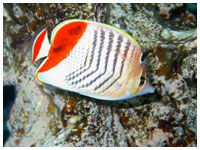 |
|
Ras Mohammed: |
| (shown to the right) situated at the peak of the Sinai Peninsula, 53 km. from Sharm Al Shiekh and its narrowest part between the Gulfs of Suez and Aqaba. It is renowned for having the most exquisite coral reefs in the world and for being a refuge to rare marine life. It has recently declared a nature preserve and most fit for diving. It houses the infamous shark reef, Sharks Observatory, Fisherman’s Bank: (Jack fish Alley) and Ras Zaatar reef. |
| |
|
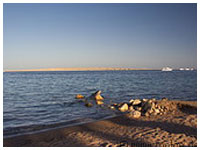 |
SHA’AB ALI REEFS |
| The Wreck of Dunraven, the Wreck of Sarah H. and the Wreck of Thistlegorm. The Thistlegorm, loaded with military equipment of all kinds for the British troops in North Africa, was hit and sunk by a German fighter plane. But today the Thistlegorm has returned from the dead to become the vital hub of wreck diving in the Red Sea, and one of the most sought after wreck dives in the entire world. |
| |
|
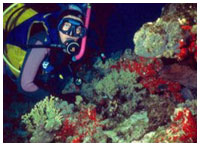 |
THE STRAITS OF GOBAL: |
| Is located south of the sinai penisula and in the path way of commercial linners, the streets of gobal throughout time has become a grave yard for ships among the most intresting wrech dives in the area are : The Wreck of Chrisoula K, The Wreck of Giannis D. and the Wreck of Cranatic. |
 Top
Top |
 |
 |
|
THE DEEP SOUTH: This area is unacciessible except by boats, its well known for being a virgin area and has a lot of big fish ( sharks, groopers, mantarese and dolphins ).
We visit a lot of spectacular dive spots like (Elphinstone Reef, Abou Dabab and Dolphin Reef:). |
|







